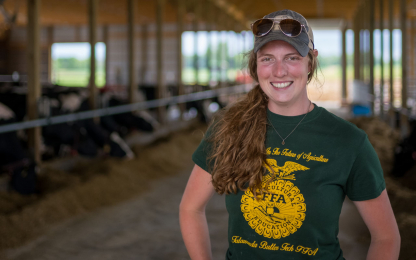Growing pistachios is a time-consuming, capital-intensive business and depends on high-tech resources to make it profitable. But Dr. Bart Heuler, a retired dentist in his 80s, has what it take to make that happen.
Bart keeps his finger on the pulse of the pistachio business. His family and partners formed A&P Ranch, which grows more than 10,000 acres of pistachios, pecans and almonds in California and Arizona.
Additionally, Bart and other ranchers formed a producer-owned cooperative, A&P Growers. After purchasing additional land, Bart planted 2,000 acres and plans to have another 5,500 acres in nearby San Simon, Arizona, planted by 2015.
The new orchards will take 10 years to reach full production, and the trees can produce nuts, and therefore revenue, for more than 100 years. “Do you know how much fun it is to create a viable, thriving industry in Arizona?” Bart expressed.
Benefitting the growers
In 2009, Arizona produced just one percent of the nation’s pistachio crop or four million out of 358 million pounds. Bart plans to double Arizona’s output. Because A&P Growers is a farmer-owned non-profit cooperative, the benefit to the growers is clear.
According to Bart, Arizona growers have been paid more in the last few years than at any time in the last thirty years.
To obtain the highest yields, growing pistachios is a time-sensitive, capital-intensive business, and depends on high-tech plant science to make it profitable. “If you’re farming with yesterday’s technology, you won’t be farming in the future,” Bart said.
“No-brainer” lender
Partnering with Farm Credit for a short-term capital need is a “no-brainer” for him. His farms have been planting a genetically superior rootstock developed by university scientists and a nursery in California. In 2012, his team inserted buds from other pistachio varieties into these supertrees, a process similar to grafting.
“I have the oldest orchard in the world of these supertrees, and they are vastly superior to anything out there. Our ranches produce 40 percent more per acre than the U.S. average,” he says.
This harvest amounts to 30 million pounds of nuts annually, and he has standing orders from European and Asian buyers for well in excess of total annual production – in short, they’ll buy as much as he can produce. In the U.S., he sells to top-tier customers including Kraft Foods and Kroger.
A bright future for Arizona
Looking forward, he sees a bright future for Arizona pistachios.
“In comparison to California pistachios, Arizona pistachios look a little greener, their flavor’s a little better, and they’re free of aflatoxin,” Bart says, referring to a mold that affects pistachios grown in other areas. And he’ll keep looking for ways to improve his yields, saying, “As technology evolves in both plant science and farming techniques, we evolve.”



